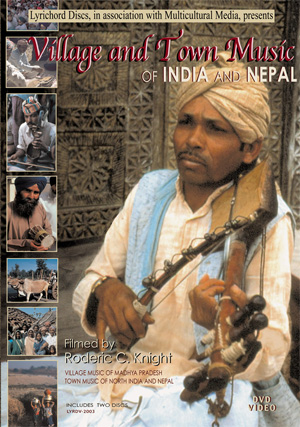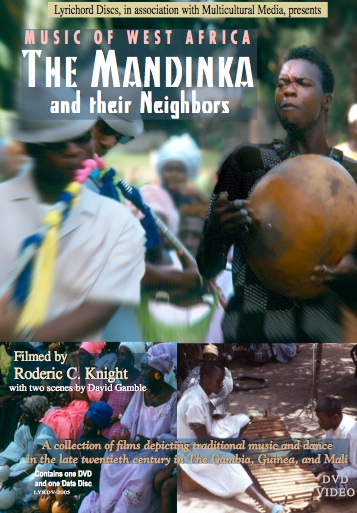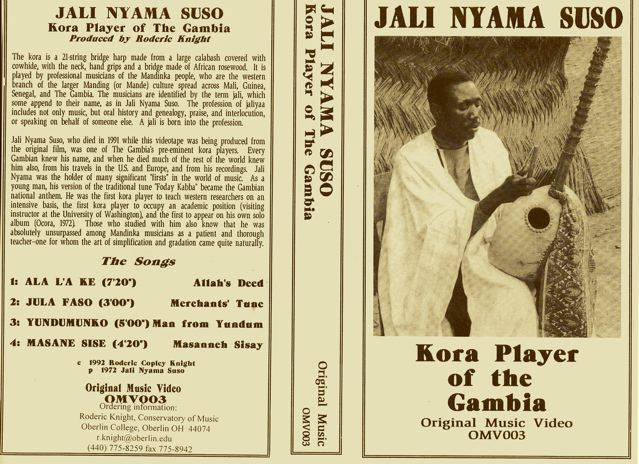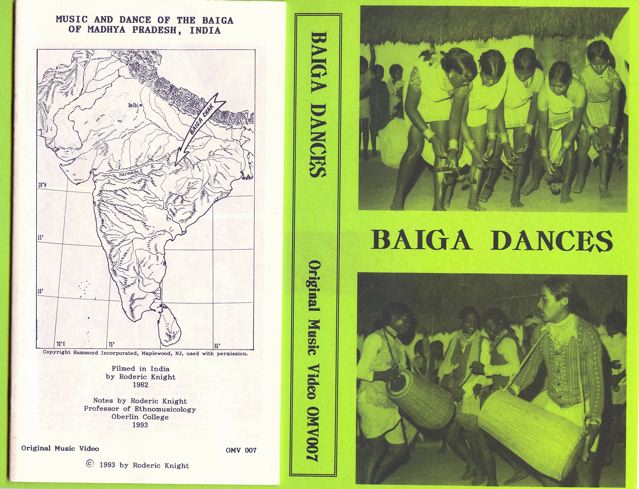RODERIC KNIGHT'S VIDEOTAPES
|
Mande
Music and Dance
now on DVD: To order for $29, click the picture. (For a library order, please go to the bottom of the Lyrichord page for the performance rights edition.) |
This DVD contains eighteen scenes filmed originally
on Super 8
movie film in 1970 and 1982. They were released on VHS in the 1990s by
Original Music as Music of the Mande, Parts I, II, and III. For the DVD edition the accompanying booklet has been rewritten and expanded to include all song texts and translations in PDF format on a separate disc. All of the scenes from Music of the Mande videotapes Parts I, II, and III are included and have been carefully re-edited and brought into sync wherever possible. See detailed contents below. If you bought the VHS tapes, please upgrade your collection with this new edition. Part I. Music for the Warriors,
Hunters, and Ordinary People (15 min.) 1. The bolon, four-string harp
of the warriors
-- 2:35 Part II. Professional Music: Mandinka
jaliyaa with the kora (47
min.) 1. The president of Sierra
Leone visits
Gambia -- 2:30 Part III. Tantango
drumming. This part consists of five scenes featuring the Mandinka drum ensemble of sabaro
and two kutiro drums in a variety of settings, with different
drum troupes (34:25 min.) |
 To order for $29, click the picture. (For a library order, please go to the bottom of the Lyrichord page for the performance rights edition.) |
Village
and Town Music of India and Nepal
Lyrichord LYRDV-2003 This package includes one 67 minute DVD and one data CD of notes, maps and photos in PDF format, plus two supplemental audio tracks. The forested hills and valleys of the eastern Narmada River in Madhya Pradesh, India attracted Rudyard Kipling a century ago, and more recently, Roderic C. Knight, professor of ethnomusicology at Oberlin College. The footage was originally made with a Super 8 sync-sound film camera during field research in 1982. There are twelve scenes, encompassing a variety of musical performances and activities of daily life. Accompanying the DVD is a CD-ROM with a 36-page booklet that may be viewed on screen or printed, documenting each event with maps, photographs, information on the cultural and historical setting, song texts and translations, and detailed musical transcriptions for two of the performances (see I-1 and II-4 below). Also included are over fifty supplementary color photographs with captions, suitable for classroom presentation. PART I. VILLAGE MUSIC OF MADHYA PRADESH 30:30 Filmed in Dindori District and Jabalpur 1. The Pardhan bana, a three-string fiddle 2. The Gogia Pardhan bin-baja, a strummed harp 3. Gond Stilt Dance and “Kabadi” game by school boys 4. Gond and Pardhan at work on farms and roads 5. The Ahir algoza, a bamboo fingerhole trumpet PART II. TOWN MUSIC OF NORTH INDIA AND NEPAL 37:00 Filmed in Nagpur, Raipur, Bhopal, Jabalpur, Chandigarh, and Kathmandu 1. Daily Work Scenes: carting, threshing, pottery making 2. Itinerant Musicians sing “Matti ke Putle” 3. A Sikh Celebration of Baisakhi: singers with harmonium, tabla, tumbi, sarangi, and tudd 4. A Sikh Wedding: the street parade, the welcoming 5. A Gaine Singer of Nepal with sarinda |
 To order for $29, click the picture. (For a library order, please go to the bottom of the Lyrichord page for the performance rights edition.) |
Music of West Africa: The Mandinka and their Neigbors Lyrichord LYRDV-2005 Filmed in The Gambia, Guinea, and Mali in 1970 and 1987 by Roderic Knight with two scenes by David Gamble This is a collection of films made with a Super 8 movie camera. The Gambian scenes were made in 1970 with a silent camera, the sound recorded on a Nagra III tape recorder. The scenes from Guinea and Mali (nos. 5 and 6), were made with a sound-sync Super 8 camera. Digital technology, expertly implemented by Elio Trabal, Oberlin College class of 2004, has enabled the release of these glimpses of late twentieth-century musical activities. There are ten scenes, two contributed by renowned Gambian expert David Gamble. The total duration is 33 minutes. 1. A Mandinka kullio (child-naming) at the Gambian State House 2. A Fula ensemble of flute, rattle, & calabash 3. Musicians and the Gambian president at political rallies 4. The Balanta xylophone 5. Manyo debero (bride's hair braiding) with xylophones, Guinea 6. The tama hourglass drum, Serahuli style, in Bamako, Mali 7. Mandinka women hoeing and singing. Filmed by David Gamble. 8. Jola men plowing and singing. Filmed by David Gamble. 9. The Jola kumpo, a "whirling haystack" masked dance 10. The Jola bugaarabo, a drum dance for celebratory occasions Accompanying the DVD is a CD-ROM with a 24-page booklet that may be viewed on screen or printed, documenting each event with maps, photographs, information on the cultural and historical setting, technical notes, and song texts and translations, and two song transcriptions. Also included are 59 supplementary color photographs with captions, suitable for classroom presentation. |
 This is a VHS tape. It may be purchased directly from me for $20, or $14 for students. Payment may be made by Paypal to rknight@oberlin.edu, or mail a check to Roderic Knight, 89 Pyle Rd., Oberlin, OH 44074. DVD edition forthcoming. |
Jali
Nyama Suso, Kora Player of The Gambia (20 minutes)
This film was made at the University of Washington in 1972, at the end of a one-year residency by Jali Nyama Suso, a renowned player and teacher of the 21-string Mandinka harp called the kora. He died in 1991. The film was made in a studio under the direction of Dr. Robert Garfias with two 16mm sync-sound cameras. The scenes alternate between full-figure shots and closeups of the hands. Although the sound is not high fidelity, the performances are exemplary of Nyama Suso's energetic style. An 8-page booklet provides background information and a synopsis of the song contents. The songs performed are as follows: 1. Alla l'a Ke (Allah's Deed) |
 This is a VHS tape. It may be purchased directly from me for $20, or $14 for students. Payment may be made by Paypal to rknight@oberlin.edu, or mail a check to Roderic Knight, 89 Pyle Rd., Oberlin, OH 44074. DVD edition forthcoming. |
Baiga
Dances (40 minutes)
This VHS video includes seven scenes filmed in Madhya Pradesh, India in 1982 with a sync-sound Super 8 movie camera. The Baiga people live in the forests of the Maikala Hills near Amarkantak, the source of the Narmada River. The young people of the village perform songs and dances at weddings, festivals, and in good-natured competition between villages. A 24-page booklet provides extensive background information, examples of song texts, and notations of some of the drum rhythms. Scenes in Silpidi Village -- 1:45
Excerpts of Weddings Baiga Dances |